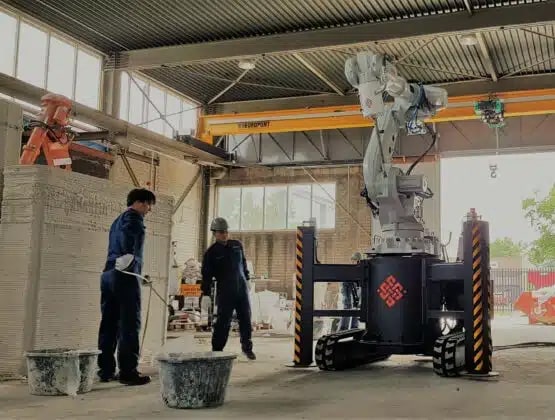Revolutionary RobotCrawler prints artificial reef
An innovation that improves marine life, combats erosion or optimizes wave action for surfers.
By creating artificial reefs, there is a solution to important ocean problems. Cybe Construction supplied a RobotCrawler for producing 3D artificial reefs. In this article we will tell you more about this, the reason is of course that Apex Dynamics gearboxes are incorporated in this unique robot.
Cybe Construction from the city Oss is known for its unique solutions in the field of 3D printing of concrete and is seen as a leader in the industry. An interesting, but for many people unknown application of 3D printed concrete is in artificial reefs.
What is an artificial reef?
A man-made underwater structure that enhances marine life in areas with a generally featureless bottom.

The reef acts as a stimulant for marine life in areas with a normally featureless bottom, but can also prevent erosion, block the passage of ships, prevent the use of trawls or improve surfing. Artificial reefs can show a rapid increase in local fish populations, coral reef and algae growth. It is considered an important solution to the problems of our oceans. Due to the roughness of the 3D printed concrete, it has a better chance of retaining certain elements such as coral.
Applications of an artificial reef
Artificial reefs can be used for a variety of purposes. They can prevent coastal erosion, or they can force waves to release their energy elsewhere rather than directly onto the shoreline. This allows you to direct the force of those waves. Other reefs are designed to trap sediment on beaches. The elements for this reef are designed to develop the resilience of mangrove and coral ecosystems and to mitigate the effects of ocean swell. In short, it is a huge benefit to marine life in general.
Why 3D Print an Artificial Reef?
The effects of climate change on marine ecosystems and coastal areas pose a number of technical, ecological and human challenges. When 3D printing is used as a production method for these elements, each unit produced can differ in characteristics. Without the need for different molds. This increases the diversity of the habitat and the richness of species on the reef. Through this efficient process, 3D printed artificial reefs are produced at relatively low costs and result in highly sustainable measures to stimulate marine life.
RobotCrawler from Cybe Construction
 The artificial reefs are printed with the RobotCrawler from Cybe Construction. This uses the APEX Dynamics ABR115 gearboxes to stamp the printer. 3 gearboxes are used per RobotCrawler to always position it stably. These gearboxes are characterized by their compact design, high load capacity, long life and optimal materials for the harsh environmental conditions. (Wind, water, sand, temperature, etc.)
The artificial reefs are printed with the RobotCrawler from Cybe Construction. This uses the APEX Dynamics ABR115 gearboxes to stamp the printer. 3 gearboxes are used per RobotCrawler to always position it stably. These gearboxes are characterized by their compact design, high load capacity, long life and optimal materials for the harsh environmental conditions. (Wind, water, sand, temperature, etc.)
Want to know which gearbox best suits your application? Then contact the Apex Dynamics team.
Curious about other applications of the RobotCrawler or innovation from Cybe Construction? Take a look at their website.





